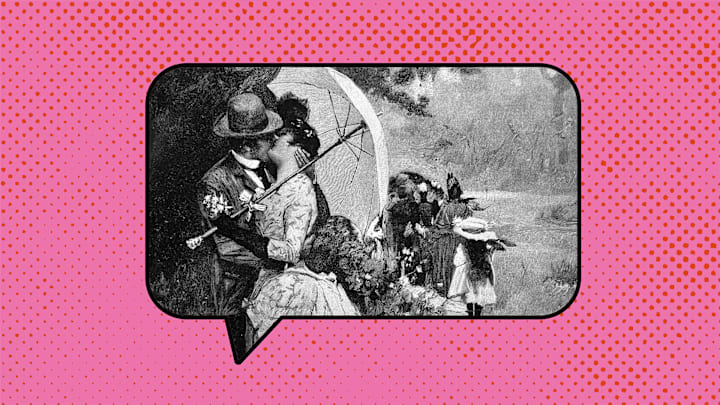Honey, baby, and sweetheart are all well and good, but what if you called the love of your life “shat” instead? Here are 10 evocative terms of endearment that you don’t hear too often these days—which might be for the best.
Babelet
If babe is too mainstream for your taste, you could call your sweetheart “babelet” instead. The term first appeared during the 19th century in reference to actual babies—tiny babies in particular. Take, for example, this 1856 poem written by a lady who hated hearing babies cry:
“O babelet, why that tearlet,
A gleaming in thy eyelet,
Thy heartlet—babelet—dearlet,
Should never know a sighlet,
A smiley on thy liplet
Should glisten, little lovelet,
Of Joy’s cup take a siplet,
Don’t cry, my pretty dovelet.”
Chickabiddy

Biddy is another word for chick, so 18th-century English speakers mashed the two together to create chickabiddy, typically used for a child or woman. Chick has been used to the same effect on its own at least since the late 16th century.
Cocky
Chick isn’t the only vintage term of endearment from the poultry world. There’s also hen, a Scottish colloquialism referring to a precious girl or woman; and cocky, a formerly gender-neutral British and Irish term later used mainly for men. Robert Burns once signed off a letter in verse to his fellow poet Thomas Blacklock with “And gratefully my gude aulde Cockie / I’m yours for ay.” (For ay meaning “forever.”)
Crowdie mowdie
In the early 16th century, Scottish poet William Dunbar wrote a satirical poem—known by its opening line, “In Secreit Place This Hyndir Nycht”—in which courtly lovers honor each other with creative, raunchy, and occasionally incomprehensible turns of phrase. One of them is crowdie mowdie, a cutesy term of endearment seemingly referring to crowdie (porridge or gruel), though it’s also been interpreted more specifically as “moldy gruel.” Another apparent Dunbar original from the poem is slawsy gawsy, which could mean “rosy slowpoke.” You can’t get much more romantic than that.
Honeysop

Honeysop originally referred to a piece of bread dipped in honey—not a bad thing to be called, especially compared to moldy gruel.
Nick-o-fidge
All we know about nick-o-fidge is that it’s been around since the early 17th century, people applied it to small children and infants, and usage is now specific to Lincolnshire, England (though it’s rare even there). The term’s origins are a mystery, but maybe it’s worth pointing out that fidge means “the state of being fidgety”—which small children and infants are pretty famous for.
Nobs
Nobs, for a female sweetheart, had its heyday in the 16th century. The Oxford English Dictionary doesn’t even have a guess as to where it came from, but it often showed up alongside other terms of endearment like coney (literally, “rabbit”). “My mouse my nobs and cony swete / My hope and {joy} my whole delight,” one character proclaimed in the anonymous play The Trial of Treasure, published in 1567.
Piggy-wiggy

It’s hard to imagine anyone deploying piggy-wiggy in a serious declaration of love—and probably no one has. The OED has it labeled “Chiefly nursery and humorous,” and you can use it for a prized person or a prized pig.
Shat
And it’s hard to imagine anyone deploying shat as a term of endearment, period. According to the OED, the word was only used for Irish people, which makes sense when you know its origin: séad, the Irish word for “jewel.”
Tootsicums
Also obsolete is tootsicums, a 19th-century term of endearment derived from tootsie (typically applied to a beloved girl or woman) and -icum, a common Latin noun ending. It was also used to describe a woman’s feet, as tootsie still is.
Learn More About Words:
